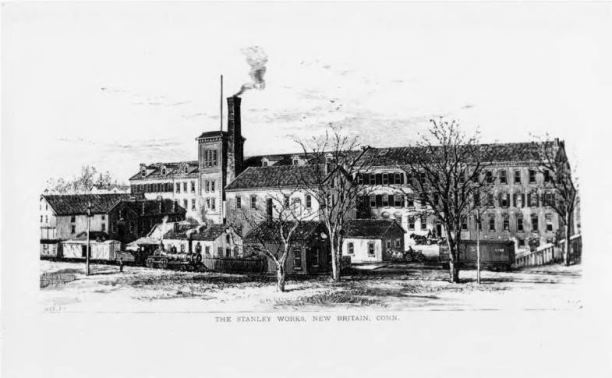In 1843, Frederick Stanley founded a small shop in New Britain to manufacture bolts, hinges, and other hardware products for sale to local residents. Years of quality products and innovation followed and Stanley’s enterprise grew into one of the largest and most successful hardware companies in the world. Throughout Stanley’s success, the company remained dedicated to not only promoting its brand and expanding its product lines but also to improving the lives of those in the New Britain community.
Frederick Stanley and William Hart Forge Success in Hardware Business
The company known to New Britain residents for over a century as Stanley Works actually got its start as two separate companies. Frederick Stanley’s enterprise took many forms involving a variety of business partners before he established his wrought-iron bolt manufactory in 1843. His success in the bolt business soon encouraged Stanley to expand into forging other types of hardware such as hooks and hinges. This hardware business became Stanley Works in 1852.
Two years later, in 1854, Stanley hired 19-year-old William Hart, who turned out to be such a visionary that he received a promotion to secretary/treasurer of the company after just a few months. Hart proved the driving force behind much of the company’s success, designing new machinery and inventing the process for cold rolling steel.

Line drawing of Stanley Works, New Britain, ca. 1879 – Hartford Public Library, Hartford History Center, Hartford Time Collection and Connecticut History Online
While Hart engineered the rise of Stanley Works, Frederick Stanley began establishing a company tradition of community service—one that continues to this day. Stanley involved himself in the creation of a local gas light company in 1855 and, two years later, proved instrumental in helping bring the first running water to New Britain. In 1871, he even served as New Britain’s first mayor.
By the turn of the century, the name Stanley was a fixture, not only in New Britain but at hardware stores across the country. By the time of William Hart’s passing in 1919, the company’s sales had grown from a mere $7,000 a year to $11.3 million over the prior six decades and left Stanley poised for the next stage of its development.
Bailey Plane Leads Company’s Expansion into Hands Tools
In 1920, Stanley Works purchased the business of Stanley Rule & Level, a New Britain business organized as a joint stock company in 1857. Stanley Rule & Level manufactured levels and squares and, perhaps most famously, the Bailey Plane. The success of the Bailey Plane allowed Stanley Rule & Level to branch out into the production of other hand tools, and by 1900, the company was the largest manufacturer of planes and related tools in America.

Woman working in the Stanley plant operating a machine which cuts out material for steel bullet jackets, New Britain, ca. 1943 – Library of Congress, Prints and Photographs Division, Office of War Information
The success of Stanley Works in the decades that followed came not only from a dedication to producing quality tools but from the foresight company executives had in branding their product. Stanley ran advertisements in popular magazines in the 1920s that encouraged fathers and sons to work together on do-it-yourself projects. During the Great Depression, Stanley placed their products in industrial and vocational schools, assuring brand loyalty from future generations of industrial professionals.
The postwar era witnessed Stanley diversify its product line and expand its operations through a number of strategic acquisitions. The result was even greater branding for Stanley on an international scale and the movement into a new $8-million headquarters in New Britain on August 1, 1984.
In the decades that followed, Stanley Works negotiated its way through the era of corporate consolidations and mergers by choosing new opportunities that best-fit the company’s business model, while resisting those, like the 1991 takeover bid by the Illinois-based Newell company, that threatened to sever Stanley’s long-standing relationship with the New Britain community. In 2010, Stanley merged with hardware giant Black & Decker of Baltimore, Maryland, to form Stanley Black & Decker. Today, Stanley Black & Decker continues to operate as one of the most trusted names in tools for millions of consumers across the globe.









